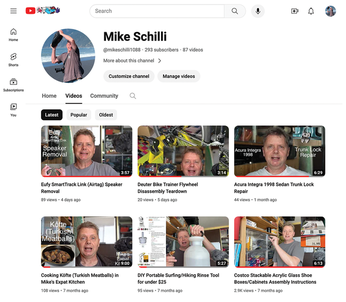Fetch and process YouTube view counts in Go
Programming Snapshot – Go YouTube Stats

Lead Image © Erik Reis, 123RF.com
To keep track of how well his YouTube videos are performing, Mike Schilli writes a Go program that uses Google's YouTube Data API to query the stats and then visualizes the results.
In my continuing quest to become immortal, I've been maintaining a YouTube channel that displays newly produced videos on an ongoing basis (Figure 1). I figured that it would be interesting to see which of my productions did best: the home cooking videos, those dealing with car repair tasks, or even those dissecting and modding all kinds of electronic gadgets. Sure, YouTube provides basic stats in its Studio section, but because I like writing my own code with custom features, I thought it'd be interesting to see how to fetch YouTube stats with Go and process and visualize the data this month.

Register Before You Try
Before granting your homegrown applications access to the viewer metadata, however, YouTube owner Google requires you to register a project [1] to use their API. The idea here is to keep an eye on bot activities and, where needed, to restrict them by imposing a quota. Google distinguishes here between two different mechanisms for authenticating incoming API requests. If requests read private user data or even want to write to the server on behalf of the user, OAuth credentials are required. But if you just want to read data that is already publicly available (e.g., the number of views for a video), all you need is an API key for a project that uses the YouTube Data API (Figure 2), which you can quickly register on the Google Console.
[...]
Buy this article as PDF
(incl. VAT)
Buy Linux Magazine
Subscribe to our Linux Newsletters
Find Linux and Open Source Jobs
Subscribe to our ADMIN Newsletters
Support Our Work
Linux Magazine content is made possible with support from readers like you. Please consider contributing when you’ve found an article to be beneficial.

News
-
Mozilla Plans to AI-ify Firefox
With a new CEO in control, Mozilla is doubling down on a strategy of trust, all the while leaning into AI.
-
Gnome Says No to AI-Generated Extensions
If you're a developer wanting to create a new Gnome extension, you'd best set aside that AI code generator, because the extension team will have none of that.
-
Parrot OS Switches to KDE Plasma Desktop
Yet another distro is making the move to the KDE Plasma desktop.
-
TUXEDO Announces Gemini 17
TUXEDO Computers has released the fourth generation of its Gemini laptop with plenty of updates.
-
Two New Distros Adopt Enlightenment
MX Moksha and AV Linux 25 join ranks with Bodhi Linux and embrace the Enlightenment desktop.
-
Solus Linux 4.8 Removes Python 2
Solus Linux 4.8 has been released with the latest Linux kernel, updated desktops, and a key removal.
-
Zorin OS 18 Hits over a Million Downloads
If you doubt Linux isn't gaining popularity, you only have to look at Zorin OS's download numbers.
-
TUXEDO Computers Scraps Snapdragon X1E-Based Laptop
Due to issues with a Snapdragon CPU, TUXEDO Computers has cancelled its plans to release a laptop based on this elite hardware.
-
Debian Unleashes Debian Libre Live
Debian Libre Live keeps your machine free of proprietary software.
-
Valve Announces Pending Release of Steam Machine
Shout it to the heavens: Steam Machine, powered by Linux, is set to arrive in 2026.

